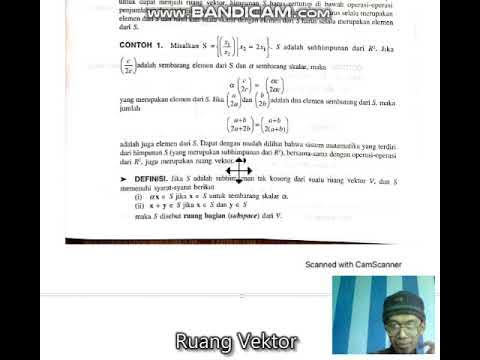Vector Space
Summary
TLDRIn this video, the concept of vector spaces in linear algebra is explained in a clear and engaging manner. The host breaks down the abstract idea by emphasizing two key operations: addition and scalar multiplication, showing how they work within a set of vectors. Using relatable examples, the video demonstrates how vector spaces can include polynomials, matrices, derivatives, and real numbers. The explanation also covers essential axioms that define vector spaces, making complex concepts easier to grasp for students transitioning from algebra to linear algebra. The goal is to simplify the concept and make it more accessible.
Takeaways
- 😀 A vector space is a set of vectors that can undergo two operations: addition and scalar multiplication.
- 😀 Vectors in a vector space can be added together, and the result will also be a vector in the same space.
- 😀 Scalar multiplication allows vectors to be stretched or compressed by multiplying them by a scalar (real number).
- 😀 A vector space must satisfy specific axioms, such as commutative and associative properties of addition.
- 😀 The zero vector must exist in a vector space, and adding it to any vector doesn’t change the other vector.
- 😀 Each vector in a vector space must have an additive inverse, meaning there’s a vector that when added to it gives the zero vector.
- 😀 The number one acts as the multiplicative identity in a vector space, meaning multiplying any vector by one leaves it unchanged.
- 😀 Vector spaces can be formed from different types of objects, like polynomials, matrices, and even functions like derivatives.
- 😀 The set of polynomials of the first degree forms a vector space because you can add and scale them while staying within the set.
- 😀 Axioms for scalar multiplication include properties such as distributing over vector addition and scalar addition.
- 😀 Real-world examples like polynomials, matrices, and derivatives help illustrate how vector spaces work and their importance in linear algebra.
Q & A
What is the main goal of the video?
-The main goal of the video is to explain what vector spaces are, making the concept clearer for students transitioning from algebra to calculus and linear algebra.
What are the two essential operations in a vector space?
-The two essential operations in a vector space are addition and scalar multiplication. Vectors can be added together and multiplied by scalars (real numbers) without leaving the vector space.
What is meant by 'scaling' in a vector space?
-'Scaling' refers to multiplying a vector by a scalar, which changes the size of the vector but keeps its direction. The vector may either become larger or smaller, but it remains in the vector space.
What does the definition of a vector space involve?
-A vector space is a set of vectors where addition and scalar multiplication are defined. These operations must result in vectors that still belong to the vector space.
Can you give an example of a vector space?
-An example of a vector space is the set of polynomials of degree 1, such as x + 1. You can add these polynomials or multiply them by scalars, and the results will also be polynomials of degree 1.
What are the axioms of a vector space?
-The axioms of a vector space define how addition and scalar multiplication should behave. They include properties like commutativity, associativity, existence of a zero vector, additive inverses, and scalar distribution properties.
What is the zero vector, and why is it important?
-The zero vector is a special vector that, when added to any vector, does not change the value of the original vector. It serves as the additive identity in the vector space.
What is the significance of the additive inverse in a vector space?
-The additive inverse of a vector is a vector that, when added to the original vector, results in the zero vector. This ensures that for every vector, there is an opposite vector that cancels it out.
What does scalar multiplication have to do with the identity element?
-Scalar multiplication in a vector space includes the multiplicative identity element, which is 1. When any vector is multiplied by 1, it remains unchanged, ensuring that scalar multiplication behaves consistently.
What does the distributive property of scalar multiplication state?
-The distributive property of scalar multiplication states that when multiplying a scalar by a sum of vectors, the scalar can be distributed across the vectors. For example, A * (U + V) = A * U + A * V.
Outlines

This section is available to paid users only. Please upgrade to access this part.
Upgrade NowMindmap

This section is available to paid users only. Please upgrade to access this part.
Upgrade NowKeywords

This section is available to paid users only. Please upgrade to access this part.
Upgrade NowHighlights

This section is available to paid users only. Please upgrade to access this part.
Upgrade NowTranscripts

This section is available to paid users only. Please upgrade to access this part.
Upgrade NowBrowse More Related Video
5.0 / 5 (0 votes)





